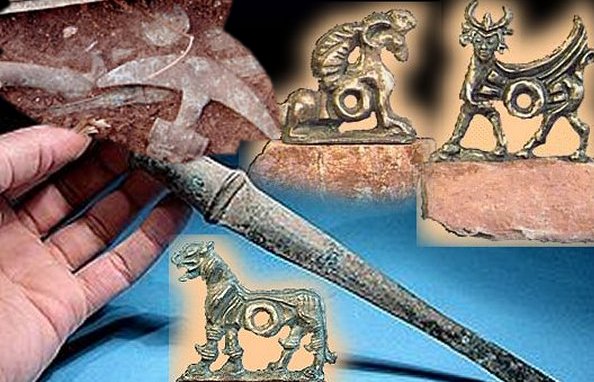A. Sutherland – MessageToEagle.com – The so-called Lorestan bronzes, from the region of the upper valleys of the Zagros Mountain chain, were first discovered in the late twenties and early thirties. The majority of them are dated back to the first millennium BC.
Lorestan’s historic sites are considered unique. Metal workshops dated to the bronze and iron ages and metal industries, closely supervised and centrally controlled, left behind a legacy of beautiful examples of metalwork.
The region’s metal workshops and their craftsmen and smiths produced exquisite and very elaborate artifacts.
The art of Lorestan manufactured between 2500 B.C. and 650 B.C., can be characterized as the art of herdsmen or horsemen constantly in movement, so their objects like arms, bridle bits, harness rings and other utensils, were all portable and small, but all of them were finely decorated.
Both men and women were buried with grave offerings, however, the graves of men specifically contained bronze daggers.
The earliest of these relics is a bowl with inscription to a king who reigned from 2,624 to 2,603 BC.
The history of these illiterate people is difficult to reconstruct and it can only be based on the written historical records of their powerful neighbors, which means the Elamites of Khuzistan with their capital at Susa, and the Babylonians in southern Iraq.
The earliest bronze artwork, especially daggers and axes, exhibit certain parallels in shape to Mesopotamian relics dated to 3000 BC.
A few years ago, old beautiful bronze artifacts were unearthed when archaeologists excavated the old cemetery of Babajilan dated to the Iron Age (1400-550 BC). Babajilan cemetery – located in a mountainous region in Lorestan province, Iran – dates back to Iron Age (550-1350 BCE) when it was the flourishing center of bronze industry in this region.
However, this important historical place is extremely endangered because of activities of illegal diggers searching for treasures. Weather conditions often do not allow the conduct any archaeological works at all. Despite harsh climate, uncomfortable location of the site and illegal artifact hunters(!) archaeologists rescued some valuable relics forgotten by plunders.
The relics like jars, bronze daggers, and many earthen objects have been collected in the cemetery’s prehistoric area.
According to Ata Hassanpour, archeologist of Lorestan’s Cultural Heritage if Iran, “illegal diggers understandably have no trainings in how an artifact must be unearthed without being damaged and therefore cause lots of harms to these ancient relics while digging. This is why large numbers of historic artifacts are destroyed before they go under studies by experts…”
In 1930, a large quantity of priceless bronze artifacts, mostly dated to the first millennium BC and stolen from prehistoric tombs of Lorestan, appeared on the Iranian and European antiquities markets.
See also:
Ancient Human Remains In The Zagros Mountains Can Re-Write History
Beautiful Ancient Viking Jewelry Made By Skilled Craftsmen
Mysterious Ancient Vinca Culture And Its Undeciphered Script
More Fascinating Ancient Artifacts
The Iron Age cemetery of Babajilan has many times been plundered by illegal diggers, who left countless ancient artifacts destroyed as a result of their illegal activities.
A two thousand-year old bronze coffin containing a skeleton with golden blindfold and muzzle was found by archaeologists in a farm near Khorram-abad, in western province of Lorestan.
The golden blindfold and muzzle indicates that they belonged to a person from high class, according to Jalal Adeli, the head of excavation group.
The coffin has dimensions of 180x87x55cm and is similar to a bathtub with four helves. The blindfold and muzzle which were found over the skeleton was made of narrow golden layer and the ceramics, which were found around the coffin, can be traced back to Parthian era.
The only bronze coffin found so far in the region, was related to Arjan treasure which belonged to Kiddin-Khutran, the Elamite king.
In the area of Sang-Tarashan (Sangtarashan) historical site, there were unearthed hundreds of unique bronze objects; among them there is for example, a 24 centimeter-long bronze dagger, dated to circa the first millennium BC and found rather incidentally.
Another object is a beautiful bronze glass with a very delicate etching work on its body and the design of a lotus flower on its bottom.
Among the unearthed relics are different kinds of swords in different sizes, battle axes, ornamental and military blades, cutlasses, a number of bronze, fragile teapots, pitchers, bowls and glasses dated to the Iron Age.
It’s also worth mentioning is the discovery of two iron swords found in the same position they had been inserted in the ground with the tips inserted in one spot and the handles forming a ‘V’ shape.
It would mean the excavated area could be a sacred place and all relics were brought to Sang-Tarashan site as gifts.
The smiths and craftsmen of prehistoric Lorestan created a rich variety of bronze and iron objects that were deposited in the region’s cemeteries from about 2600 BC to 650 BC.
Written by A. Sutherland – MessageToEagle.com Staff Writer
Copyright © MessageToEagle.com. All rights reserved. This material may not be published, broadcast, rewritten or redistributed in whole or part without the express written permission of MessageToEagle.com








